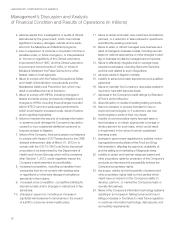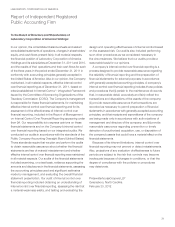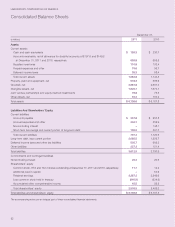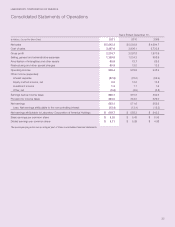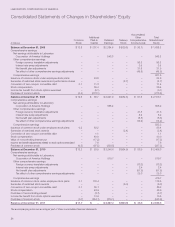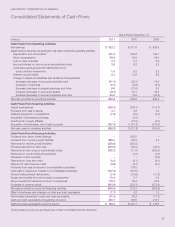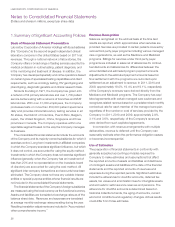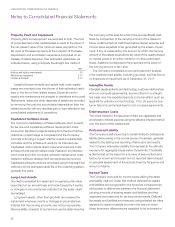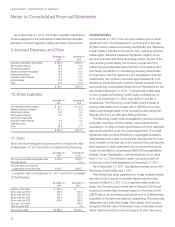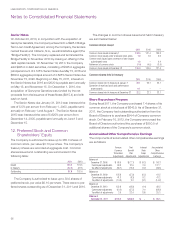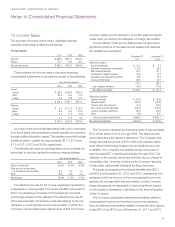LabCorp 2011 Annual Report Download - page 29
Download and view the complete annual report
Please find page 29 of the 2011 LabCorp annual report below. You can navigate through the pages in the report by either clicking on the pages listed below, or by using the keyword search tool below to find specific information within the annual report.
27
LABORATORY CORPORATION OF AMERICA
Notes to Consolidated Financial Statements
Concentration of Credit Risk
Financial instruments that potentially subject the Company to
concentrations of credit risk consist primarily of cash and cash
equivalents and accounts receivable.
The Company maintains cash and cash equivalents with
various major financial institutions. The total cash balances on
deposit that exceeded the balances insured by the F.D.I.C.,
were approximately $63.1 at December 31, 2011. Cash
equivalents at December 31, 2011, totaled $48.5, which
includes amounts invested in money market funds, time
deposits, municipal, treasury and government funds.
Substantially all of the Company’s accounts receivable are
with companies in the health care industry and individuals.
However, concentrations of credit risk are limited due to the
number of the Company’s clients as well as their dispersion
across many different geographic regions.
Accounts receivable balances (gross) from Medicare and
Medicaid were $138.3 and $125.0 at December 31, 2011 and
2010, respectively.
Earnings per Share
Basic earnings per share is computed by dividing net earnings,
less preferred stock dividends and accretion, by the weighted
average number of common shares outstanding. Diluted
earnings per share is computed by dividing net earnings
including the impact of dilutive adjustments by the weighted
average number of common shares outstanding plus
potentially dilutive shares, as if they had been issued at the
earlier of the date of issuance or the beginning of the period
presented. Potentially dilutive common shares result primarily
from the Company’s outstanding stock options, restricted
stock awards, performance share awards, and shares issuable
upon conversion of zero-coupon subordinated notes.
The following represents a reconciliation of basic earnings per share to diluted earnings per share:
2011 2010 2009
Per Share Per Share Per Share
Income Shares Amount Income Shares Amount Income Shares Amount
Basic earnings per share
$519.7 100.0 $5.20 $558.2 103.0 $5.42 $543.3 107.4 $5.06
Stock options – 0.9 — 0.6 — 0.5
Restricted stock awards and other – 0.3 — 0.3
— 0.2
Effect of convertible debt, net of tax – 0.6 — 1.5 — 1.0
Diluted earnings per share $519.7 101.8 $5.11 $558.2 105.4 $5.29 $543.3 109.1 $4.98
The following table summarizes the potential common shares
not included in the computation of diluted earnings per share
because their impact would have been antidilutive:
Years Ended December 31,
2011 2010 2009
Stock options 1.3 2.7 4.6
Stock Compensation Plans
The Company measures stock compensation cost for all
equity awards at fair value on the date of grant and recognizes
compensation expense over the service period for awards
expected to vest. The fair value of restricted stock awards and
performance shares is determined based on the number of
shares granted and the quoted price of the Company’s
common stock on grant date. Such value is recognized as
expense over the service period, net of estimated forfeitures.
The estimation of equity awards that will ultimately vest requires
judgment and the Company considers many factors when
estimating expected forfeitures, including types of awards,
employee class, and historical experience. The cumulative
effect on current and prior periods of a change in the estimated
forfeiture rate is recognized as compensation cost in earnings
in the period of the revision. Actual results and future estimates
may differ substantially from the Company’s current estimates.
See note 14 for assumptions used in calculating compen-
sation expense for the Company’s stock compensation plans.
Cash Equivalents
Cash equivalents (primarily investments in money market funds,
time deposits, municipal, treasury and government funds which
have original maturities of three months or less at the date of
purchase) are carried at cost which approximates market.
Inventories
Inventories, consisting primarily of purchased laboratory
and client supplies, are stated at the lower of cost (first-in,
first-out) or market.



